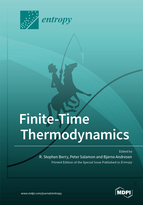Finite-Time Thermodynamics
A special issue of Entropy (ISSN 1099-4300). This special issue belongs to the section "Thermodynamics".
Deadline for manuscript submissions: closed (31 August 2020) | Viewed by 55258
Special Issue Editors
Interests: finite-time thermodynamics; structures, properties, and dynamics of clusters and biopolymers; dynamics of few-body systems
Interests: finite-time thermodynamics; geometrical thermodynamics; biomathematics; optimization and mathematical modeling
Interests: finite-time thermodynamics(FTT); application of FTT ideas in a wide range of areas; quantum, chemical, and biological systems; global optimization theory; thermodynamic geometry; thermodynamics at extreme time and length scales
Special Issue Information
Dear Colleagues,
Even though finite-time thermodynamics (FTT) is already 45 years old by now, it is still in its adolescent stage. The original horizon of classical thermodynamics with the one feature of a specified process completion time added has long been broken. Topics treated have expanded into quantum systems, engineering design, biology and evolution, information theory, and economics, just to name a few, and the way of thinking, in particular using the concept of thermodynamic geometry, has inspired, e.g., general optimization theory. FTT continues to expand into new areas where either we are interested in calculating “the cost of haste”, or we want to optimize the path of a process within given constraints. FTT has just started.
In this Special Issue on FTT, we want to show the full breadth and depth of the field, and thus, we will interpret finite-time thermodynamics broadly, both in terms of the methods used to investigate all the effects of a finite time horizon for the processes in question, and in terms of the objects investigated. In other words, the objects must not necessarily be of a thermodynamic nature but could also be engineering, economics, optimization, scheduling, and anywhere else thermodynamic thinking is useful. We also want to look ahead just as much as look back. Therefore, we welcome novel, yet untested, ideas and visions just as much as finalized research results. We hope to receive many inspiring contributions.
Prof. R. Stephen Berry
Prof. Peter Salamon
Prof. Bjarne Andresen
Guest Editors
Manuscript Submission Information
Manuscripts should be submitted online at www.mdpi.com by registering and logging in to this website. Once you are registered, click here to go to the submission form. Manuscripts can be submitted until the deadline. All submissions that pass pre-check are peer-reviewed. Accepted papers will be published continuously in the journal (as soon as accepted) and will be listed together on the special issue website. Research articles, review articles as well as short communications are invited. For planned papers, a title and short abstract (about 100 words) can be sent to the Editorial Office for announcement on this website.
Submitted manuscripts should not have been published previously, nor be under consideration for publication elsewhere (except conference proceedings papers). All manuscripts are thoroughly refereed through a single-blind peer-review process. A guide for authors and other relevant information for submission of manuscripts is available on the Instructions for Authors page. Entropy is an international peer-reviewed open access monthly journal published by MDPI.
Please visit the Instructions for Authors page before submitting a manuscript. The Article Processing Charge (APC) for publication in this open access journal is 2600 CHF (Swiss Francs). Submitted papers should be well formatted and use good English. Authors may use MDPI's English editing service prior to publication or during author revisions.
Keywords
- Finite-time thermodynamics
- Thermodynamic geometry
- Control thermodynamics
- Biological optimization
- Control economics
- Optimal control modelling









